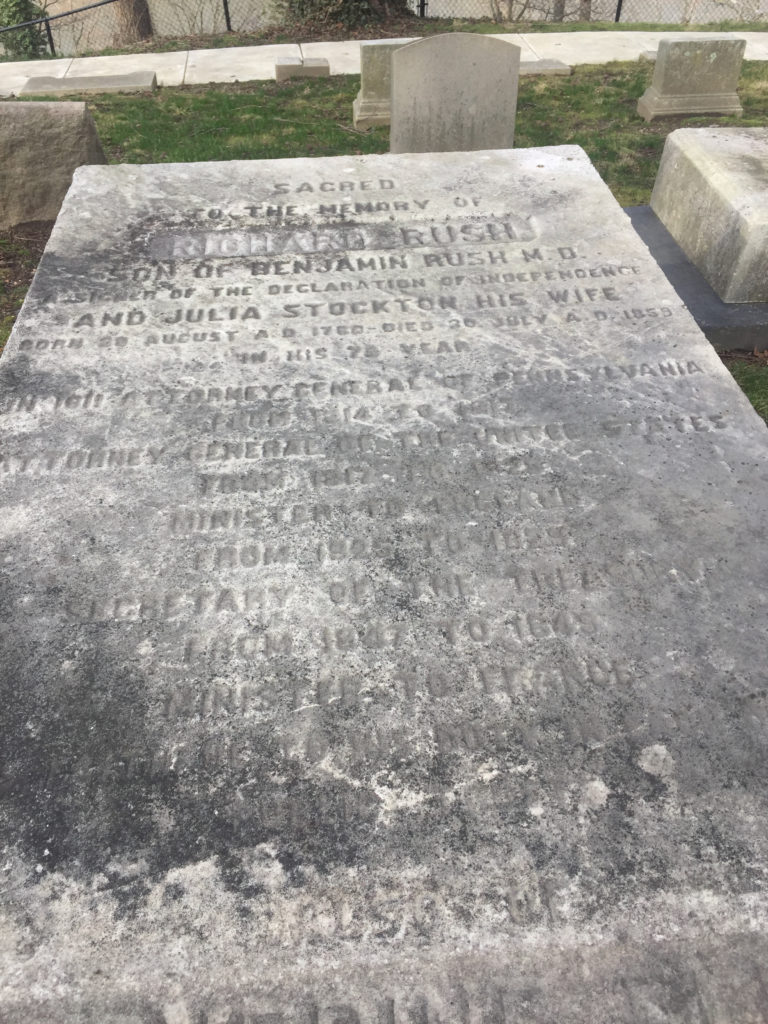Erik Visits an American Grave, Part 835
This is the grave of Richard Rush.

Born in 1780 in Philadelphia, Rush grew up in one of the elite families of the Early Republic. His father was Dr. Benjamin Rush, one of the most important people of the American Revolution. His mother was Julia Stockton Rush, the daughter of Richard Stockton, New Jersey’s top contribution to revolutionary leadership. He started at the College of New Jersey, now Princeton, in 1794 and finished in 1797. Since this always comes up with these early figures, yes attending college at this age was common at the time.
Rush passed the bar in 1800 and quickly went into politics while also practicing. He became a leading Jeffersonian, was known for his excellent public lecturing on politics, and became a leading trial lawyer. He thought about running for Congress in 1810 but chose against it. The next year though, he was appointed attorney general in Pennsylvania.
Rush only stayed in this job for a few months because later that year, his good friend and political ally James Madison named him comptroller of the Treasury. That was a nice job, but the real reason Madison brought him to Washington was to be an advisor in general. And in fact, Rush was close enough to Madison that he was a major advisor throughout the War of 1812, which by any realistic account should have been the end of the United States, but was not. Rush was a one of the War Hawks who advocated war with what was merely the strongest power in the world. Being such an excellent public speaker, when the administration needed a public speech in favor of the war, Rush was where to turn. Interestingly, he also proposed that Madison should name Thomas Jefferson as Secretary of State in 1812. In 1814, with both Treasury and AG open, Madison offered Rush his choice. He chose to become Attorney General. He was also still working in his private practice, which today would be illegal, but at the time was common as there really wasn’t that much work for the AG to do.
When James Monroe became president, Rush was the acting Secretary of State until John Quincy Adams could get back from Europe while also staying on as AG until November 1817. He actually did real work at State as well, finishing the Rush-Bagot Convention to demilitarize the Great Lakes region. Monroe then sent him to London as Minister to Britain. He was popular over there because his elite upbringing and manners made him fit into the British aristocracy well, regardless of his politics. When the Spanish colonies revolted, the British wanted the Americans to issue a joint declaration that the French shouldn’t get involved in recolonizing them. Rush was fine with that of course, but also wanted the British to make the same statement about themselves and recognize the ex-colonies as independent nations. That they would not do. So the U.S. decided to go it alone with the Monroe Doctrine. Rush was in London for the entire eight years of the Monroe administration, outside of his early months in Washington. Among his accomplishments there was fixing the Canada-U.S. border at the 49th Parallel.
When Adams became president, Rush hoped to be Secretary of the Navy, but the president named him as Secretary of the Treasury instead. He was fine with that, paid down the debt, and ended his four years there with a surplus. He had become a big supporter of the Second Bank of the United States, demonstrating his shifting politics from his early years as a Jeffersonian. Close now to Adams, he was named VP for his reelection campaign (to say the least Adams and John C. Calhoun were not a good match!) but of course Jackson won and Adams lost.
Rush then served American cities in gaining loans from Europe. In 1833, he published his memoirs of his time in England as A Residence at the Court of London. Though Rush was not particularly associated with Jackson, in 1836, he was tapped to go to Britain and get the money that James Smithson left to start what became the Smithsonian Institution. Rush later went on to become one of the Smithsonian’s first regents. Rush was a bit lost politically in these years. He was an Anti-Mason for awhile. For a lot of those guys, the Whigs would be their home. Moreover, Rush was such a big supporter of the BUS and Jackson had destroyed it. But Rush got over his disdain for the kind of popular democracy that was so different from the politics of his youth and became a Democrat in the late 1830s. In 1847, James Polk named Rush Minister to France. He was one of the first diplomats to recognize the Second French Republic. Zachary Taylor recalled him in 1849 to place a Whig in the role. Rush was pretty old by this time anyway. He retired in Philadelphia, where he died in 1859 at the age of 78.
In 1872, his son, also named Richard, who had served as a diplomat in Britain during the Van Buren years, edited his father’s diaries and other writings and released them as Recollections of a Residence at the English and French Courts. And hey, if the signature of Rush is what turns you on, you can fulfill your fantasy for a mere $144!
Richard Rush is buried in Laurel Hill Cemetery, Philadelphia, Pennsylvania.
This grave visit was sponsored by LGM reader contributions. Thanks!!! If you would like this series to visit other Attorney Generals, you can donate to cover the required expenses here. John Berrien is in Savannah and Roger Taney is in Frederick, Maryland. And who doesn’t want to see me cover Taney? Previous posts in this series are archived here.


